
My goal is to merge New York State standards with Common Core Standards and Integrated Algebra Regent Standards for our 8th grade curriculum.
- Subject:
- Mathematics
- Material Type:
- Full Course
- Lesson Plan
- Syllabus
- Date Added:
- 09/09/2012

My goal is to merge New York State standards with Common Core Standards and Integrated Algebra Regent Standards for our 8th grade curriculum.

Throughout this lesson, the teacher will explain equivalent fractions, plot them on a coordinate plane, connect and extend those points, then discuss the importance of the relationship and explore what the students notice about the relationship. This lesson can help depend understanding of equivalent fractions as well as deepen the discussion into slope being similar to the fraction that we gave at the beginning of the lesson. (Math Solutions Training idea)

Throughout this lesson, the teacher will explain equivalent fractions, plot them on a coordinate plane, connect and extend those points, then discuss the importance of the relationship and explore what the students notice about the relationship. (Math Solutions Training idea)
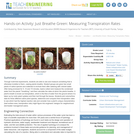
Through multi-trial experiments, students are able to see and measure something that is otherwise invisible to them seeing plants breathe. Student groups are given two small plants of native species and materials to enclose them after watering with colored water. After being enclosed for 5, 10 and 15 minutes, teams collect and measure the condensed water from the plants' "breathing," and then calculate the rates at which the plants breathe. A plant's breath is known as transpiration, which is the flow of water from the ground where it is taken up by roots (plant uptake) and then lost through the leaves. Students plot volume/time data for three different native plant species, determine and compare their transpiration rates to see which had the highest reaction rate and consider how a plant's unique characteristics (leaf surface area, transpiration rate) might figure into engineers' designs for neighborhood stormwater management plans.
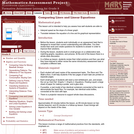
This lesson unit is intended to help teahcers assess how well students are able to interpret speed as the slope of a linear graph and translate between the equation of a line and its graphical representation.

(Nota: Esta es una traducción de un recurso educativo abierto creado por el Departamento de Educación del Estado de Nueva York (NYSED) como parte del proyecto "EngageNY" en 2013. Aunque el recurso real fue traducido por personas, la siguiente descripción se tradujo del inglés original usando Google Translate para ayudar a los usuarios potenciales a decidir si se adapta a sus necesidades y puede contener errores gramaticales o lingüísticos. La descripción original en inglés también se proporciona a continuación.)
En el módulo 4, los estudiantes extienden lo que ya saben sobre las tarifas unitarias y las relaciones proporcionales con ecuaciones lineales y sus gráficos. Los estudiantes entienden las conexiones entre relaciones proporcionales, líneas y ecuaciones lineales en este módulo. Los estudiantes aprenden a aplicar las habilidades que adquirieron en los grados 6 y 7, con respecto a la notación simbólica y las propiedades de la igualdad para transcribir y resolver ecuaciones en una variable y luego en dos variables.
Encuentre el resto de los recursos matemáticos de Engageny en https://archive.org/details/engageny-mathematics.
English Description:
In Module 4, students extend what they already know about unit rates and proportional relationships to linear equations and their graphs. Students understand the connections between proportional relationships, lines, and linear equations in this module. Students learn to apply the skills they acquired in Grades 6 and 7, with respect to symbolic notation and properties of equality to transcribe and solve equations in one variable and then in two variables.
Find the rest of the EngageNY Mathematics resources at https://archive.org/details/engageny-mathematics.
![OREGON MATH STANDARDS (2021): [8.AEE]](https://img.oercommons.org/160x134/oercommons/media/courseware/lesson/image/13138_ODE_Math_Logo_2018-H_color_BvjqVNy.png)
The intent of clarifying statements is to provide additional guidance for educators to communicate the intent of the standard to support the future development of curricular resources and assessments aligned to the 2021 math standards. Clarifying statements can be in the form of succinct sentences or paragraphs that attend to one of four types of clarifications: (1) Student Experiences; (2) Examples; (3) Boundaries; and (4) Connection to Math Practices.
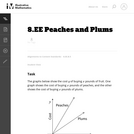
This task allows students to reason about the relative costs per pound of the two fruits without actually knowing what the costs are. Students who find this difficult may add a scale to the graph and reason about the meanings of the ordered pairs. Comparing the two approaches in a class discussion can be a profitable way to help students make sense of slope.
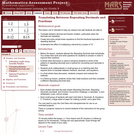
This lesson unit is intended to help teachers assess how well students are able to: translate between decimal and fraction notation, particularly when the decimals are repeating; create and solve simple linear equations to find the fractional equivalent of a repeating decimal; and understand the effect of multiplying a decimal by a power of 10.

Learn about the math, science, and human element it takes to land on and launch off an aircraft carrier.
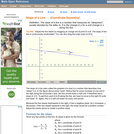
An interactive applet and associated web page that demonstrate the slope (m) of a line. The applet has two points that define a line. As the user drags either point it continuously recalculates the slope. The rise and run are drawn to show the two elements used in the calculation. The grid, axis pointers and coordinates can be turned on and off. The slope calculation can be turned off to permit class exercises and then turned back on the verify the answers. The applet can be printed as it appears on the screen to make handouts. The web page has a full description of the concept of slope, a worked example and has links to other pages relating to coordinate geometry. Applet can be enlarged to full screen size for use with a classroom projector. This resource is a component of the Math Open Reference Interactive Geometry textbook project at http://www.mathopenref.com.
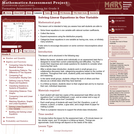
This lesson unit is intended to help teachers assess how well students are able to: solve linear equations in one variable with rational number coefficients; collect like terms; expand expressions using the distributive property; and categorize linear equations in one variable as having one, none, or infinitely many solutions. It also aims to encourage discussion on some common misconceptions about algebra.
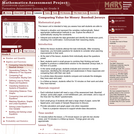
This lesson unit is intended to help teachers assess how well students are able to: interpret a situation and represent the variables mathematically; select appropriate mathematical methods to use; explore the effects of systematically varying the constraints; interpret and evaluate the data generated and identify the break-even point, checking it for confirmation; and communicate their reasoning clearly.
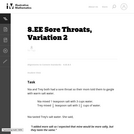
The purpose of this task is to show how the ideas in the RP and EE domains in 6th and 7th grade mature in 8th grade.
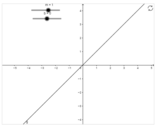
OLO: Students will be able to explain how changing the y-intercept and slope will change the appearance of the line.This lesson is to help students develop the relationship between slope(m) and y-intercept(b) by using an interactive coordinate plane to explore. This is a 2 part lesson with some teacher clarification in between the 2 parts. The teacher component in between the 2 parts is to make sure the students fully understand the relationships developed in part 1 before applying it to part 2.If you have a Face to Face class and just want a print out/editable version for Google Classroom Click Here

In this real world word problem students must graph linear equations.

سيستخدم الطلاب النسب لإظهار الروابط بين العلاقات التناسبية والخطوط والمعادلات الخطية. سيقوم الطلاب بحل المسائل بواسطة نشاط تعاوني وحركي والذي فيه سينشئون قائمة نسب، ومن ثم سيرسمون العلاقات التناسبية بأجسامهم لإظهار أن النسبة هي المنحنى الذي يمر دائمًا خلال نقطة المركز.